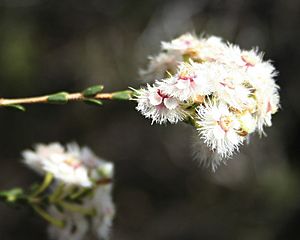Verticordia inclusa facts for kids
Quick facts for kids Verticordia inclusa |
|
|---|---|
 |
|
| Verticordia inclusa growing near Scaddan | |
| Scientific classification | |
| Genus: |
Verticordia
|
| Species: |
inclusa
|
Verticordia inclusa is a beautiful flowering plant that belongs to the myrtle family, called Myrtaceae. This plant is special because it is found only in the south-west part of Western Australia. It's a small shrub with tiny, thick leaves and groups of sweet-smelling flowers. These flowers are usually white or pale pink with a red center, and they bloom in spring at the ends of the branches.
Contents
What Does Verticordia inclusa Look Like?
Verticordia inclusa is a small shrub that usually grows to be about 0.2 to 1 meter (about 8 inches to 3 feet) tall. Sometimes, it can spread out to about 60 centimeters (2 feet) wide. Its branches are often spread out and not in a perfect shape.
Leaves and Their Shape
The leaves of this plant are shaped like an ellipse, which is like a stretched circle. If you cut a leaf in half, it would look roughly like a triangle. Each leaf is about 2 to 5 millimeters (less than a quarter of an inch) long and has a rounded tip. The leaves that grow closer to the flowers are usually a bit smaller.
Flowers: Colors, Scent, and Parts
The flowers of Verticordia inclusa have a lovely, sweet smell. They grow in round, cluster-like groups at the ends of the branches. Each flower sits on a straight stalk that is about 5 to 12 millimeters (about a quarter to half an inch) long.
The bottom part of the flower, called the floral cup, looks like a top and is about 2 millimeters long. It's mostly smooth but has some tiny hairs near its base. The sepals, which are like small leaves that protect the flower bud, are white to pale pink. They are about 3.5 to 5 millimeters long and spread out. They have 4 or 5 feathery parts with long, straight hairs.
The petals, which are the colorful parts of the flower, are shaped like an egg or are almost round. They are white to pink and have a red color near their base. These petals are about 3 to 4 millimeters long and have long, pointed edges. The style, which is a part of the flower involved in reproduction, is straight and very short, less than 0.5 millimeters long. It is also smooth, meaning it has no hairs. This plant usually blooms from August to November.
How Was Verticordia inclusa Named?
The plant Verticordia inclusa was officially described for the first time in 1991 by a scientist named Alex George. He published his description in a scientific journal called Nuytsia. The specimens he studied were found near Ravensthorpe by Alex and Elizabeth George.
Meaning of the Name
The second part of the plant's name, inclusa, comes from a Latin word that means "enclosed" or "confined." This name was chosen because the stamens (the parts that produce pollen) and the style (the part of the female reproductive organ) are hidden or "enclosed" by the petals.
When Alex George looked closely at all the plants in the Verticordia group in 1991, he placed Verticordia inclusa into a smaller group called section Catocalypta. Other plants in this group include V. roei, V. apecta, V. insignis, V. habrantha, V. lehmannii, and V. pritzelii.
Where Does Verticordia inclusa Grow?
This type of verticordia plant usually grows in sandy soil. Sometimes, it can be found where there is gravel, loam (a type of rich soil), or clay underneath the sand. It often grows alongside other kinds of verticordia plants in areas with heath (low-growing shrubs) and shrubland.
You can find Verticordia inclusa in the region between Esperance and the Fitzgerald River National Park. It also grows as far north as Moorine Rock and Coolgardie. These areas are part of different natural regions in Western Australia, including the Avon Wheatbelt, Coolgardie, Esperance Plains, and Mallee biogeographic regions.
Is Verticordia inclusa Protected?
The Western Australian Government's Department of Parks and Wildlife has looked at Verticordia inclusa. They have officially classified it as "not threatened." This means that, for now, there are enough of these plants in the wild, and they are not in danger of disappearing.
Can We Grow Verticordia inclusa in Gardens?
Even though Verticordia inclusa is a beautiful plant, it has been very difficult to grow it in gardens or nurseries. So far, people have not had much success in getting it to grow well outside of its natural habitat.
Images for kids


